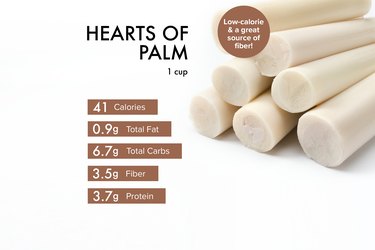
We often spot hearts of palm in the canned food aisle near the artichoke hearts or sundried tomatoes and aren't quite sure what to make of them. But you won't want to skip this underrated yet delicious and nutrient-dense veggie.
The subtle-flavored vegetable comes from the palmetto (or palm) tree and the hearts are harvested while the palm is small. An entire trimmed heart of palm looks like a large off-white or cream-colored carrot and is composed of rings, similar to a leek.
Video of the Day
Video of the Day
Heart of palm provides a wide range of vitamins and minerals and a low calorie count. It's rich in fiber, iron, copper and manganese. However, because it's primarily sold as a canned product, the sodium level can be higher than its fresh counterpart.
What Does Heart of Palm Taste Like?
Heart of palm's taste can be described as most similar to artichoke hearts or asparagus. The veggie is crunchy when you bite into it and takes on a creamy texture when you reach the center. It makes a delightful addition to salads.
Heart of Palm Nutrition Facts
One cup of heart of palm is equal to a single serving. One cup of canned heart of palm contains:
- Calories: 41
- Total fat: 0.9 g
- Cholesterol: 0 mg
- Sodium: 622 mg
- Total carbs: 6.7 g
- Dietary fiber: 3.5 g
- Sugar: 0 g
- Protein: 3.7 g
Heart of Palm Macros
- Total fat: One cup of heart of palm has 0.9 grams of total fat, which includes 0.3 grams of polyunsaturated fat, 0.2 grams of monounsaturated fat, 0.2 grams of saturated fat and 0 grams of trans fat.
- Carbohydrates: One cup of heart of palm has 6.7 grams of carbohydrates, which includes 3.5 grams of fiber.
- Protein: One cup of heart of palm has 3.7 grams of protein.
Vitamins, Minerals and Other Micronutrients
- Manganese: 88% Daily Value (DV)
- Iron: 25% DV
- Copper: 22% DV
- Zinc: 15% DV
- Folate: 14% DV
- Magnesium: 13% DV
- Vitamin C: 13% DV
- One cup of heart of palm is not a good source of vitamin A (0% DV), vitamin D (0% DV), phosphorous (8% DV), calcium (7% DV) and potassium (5% DV)
Health Benefits of Heart of Palm
Heart of palm has a rich and varied nutrient profile. It contains a wide range of vitamins, minerals and fiber.
1. Heart of Palm Is Linked to Weight Loss
Heart of palm is a good source of dietary fiber and plant-based protein, the dynamic duo that works synergistically to help support a healthy weight and weight loss.
Studies have shown that a plant-forward diet full of whole foods, such as vegetables, is an effective strategy for treating obesity, according to an article published in the November 2018 issue of Nutrition and Diabetes.
Dietary fiber, which is found only in plant foods, creates bulk that helps you feel full and your GI tract running efficiently.
Higher intake of fiber has been linked to lower body weights, as shown in the April 2013 issue of Nutrients.
2. Heart of Palm Is Packed With Iron
Heart of palm is an excellent source of iron, clocking in at 25 percent of the daily recommended value. Iron is essential to hemoglobin, a type of protein that transfers oxygen from the lungs to the tissues.
Iron also supports muscle metabolism, physical growth and neurological development, according to the National Institutes of Health (NIH).
Dietary iron has two forms, heme and non-heme. Plant-based iron sources, including heart of palm, contain non-heme iron, which is less bioavailable to humans.
Pairing non-heme iron foods with vitamin C-rich foods can help your body better absorb the mineral, according to the October 2019 issue of Antioxidants. (Vitamin C acts synergistically to reduce the non-heme form from ferric to ferrous, which allows humans to more easily absorb the nutrient.)
This is particularly important for vegans and vegetarians who primarily take in non-heme iron versus the animal-based heme iron and are more likely to experience anemia. Luckily, heart of palm is also a great source of vitamin C!
3. Heart of Palm Provides Nearly a Full Day's Dose of Manganese
One serving of heart of palm provides 88 percent of the daily recommended value for manganese, an essential trace element.
Manganese is a cofactor for many enzymes, meaning that it triggers an action in the body and is involved in a range of functions including metabolism, bone formation, reproduction, immune response and blood clotting, according to the NIH.
Is Heart of Palm Associated With Any Health Risks?
Heart of palm is generally regarded as safe for most people to consume and is not known to be associated with any food allergies or drug interactions to date.

Heart of Palm Preparation and Useful Tips
Heart of palm is most often found year-round in a canned or jarred version, which is the recommended way to purchase the vegetable.
Heart of palm can generally be found in two varieties, whole or salad-cut. If you are able to find fresh heart of palm, the following are tips to help prepare it.
Tip
When using the canned or jarred version, be sure to drain and rinse with running water to get rid of additional sodium used as a preservative.
- Select fresh hearts that are moist at both ends and have no signs of dehydration, layer separation or cracking.
- Fresh heart of palm is very perishable, so store in a closed resealable bag in the crisper drawer of your refrigerator.
- Cut lengthwise along the heart and remove any tough outer layers, looking for the tender core.
- Slice into rounds and soak in ice water for one hour.
- To make them more tender, you can steam the whole veggie, about eight to 10 minutes. You can also choose to roast them by wrapping in foil and placing them in an oven set to 400 degrees Fahrenheit for about 20 minutes.
Heart of palm is a delicious and nutrient-dense addition to many dishes. Here are some quick serving ideas to get you started:
- Add sliced or chopped heart of palm to vegetable salads, grain salads and mayo- or yogurt-based salads like egg, potato or chicken salad.
- Lightly sprinkle braised heart of palm with cayenne and herbs and serve it over watercress, mandarin orange sections, red onions and spinach.
- Steam or sauté heart of palm and serve with a squeeze of lemon, salt, pepper and some chopped herbs.
- Mix a little lime zest into olive oil and garlic and add to finely chopped, canned hearts of palm for a low-fat creamy dip.
- Dice small and add to a salmon or crab cake mixture before cooking. You can also pan-sear them as a substitute for seafood in your favorite recipe.
- Add to stir-fries, casseroles or braised dishes.
- Bread sliced hearts of palm with breadcrumbs and "fry" them in an air fryer or bake in the oven on 400 degrees Fahrenheit until golden brown.
Heart of Palm Recipes
Alternatives to Heart of Palm
If you're not a fan of heart of palm or are simply looking for similar alternatives, try artichoke hearts, which can be found fresh, jarred, canned or frozen.
Steamed or sautéed asparagus can be a good substitute in a salad as well.
- Encyclopedia Brittanica: “Acai Fruit and Plant”
- My Food Data: “Hearts of Palm”
- Nutrition and Diabetes: “A plant-based diet in overweight individuals in a 16-week randomized clinical trial: metabolic benefits of plant protein”
- Nutrients: “Fiber and Prebiotics: Mechanisms and Health Benefits
- NIH: “Iron Fact Sheet for Health Professionals”
- Vitamin C in Plants: "From Functions to Biofortification"
- NIH: “Manganese Fact Sheet for Health Professionals